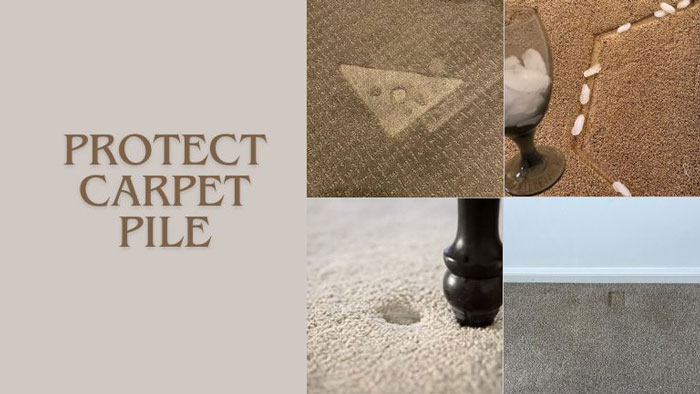Soft underfoot and rich in texture, a good carpet can transform the feel of a home. Yet heavy furniture can leave dents, indentations, and marks that spoil its look and comfort.
With the right care and a few mindful habits, your carpet can stay plush and elegant for a long time.
Understanding the Impact of Weight and Pressure
When furniture sits in one spot for too long, the pile beneath it compresses, losing shape and spring. The fibres bend and flatten under pressure, creating those familiar indentations that seem impossible to smooth out.
Shorter piles tend to recover faster, while thicker ones hold a dent for longer. Still, even the most durable carpet can tire over time when burdened with excess weight.
Different pieces of furniture affect carpets in different ways. A heavy wardrobe or dining table can press down evenly yet deeply, while a sofa with slim metal legs can leave sharper, more visible dents.
The longer the weight stays in place, the harder it becomes for the fibres to recover. That’s why prevention, rather than repair, is always the wiser route.
To understand how best to protect your flooring, think about how weight is distributed. Flat or wider surfaces spread pressure more gently across the fibres, helping them spring back into shape.
Narrow legs, on the other hand, act like small points of force. Noticing these patterns is the first step in keeping your carpet looking soft and even.
Practical Ways to Prevent Damage
A simple way to defend your carpet is by adding a layer of protection beneath each piece of furniture. Felt pads, rubber cups, or silicone feet work well for this.
They create a small buffer that softens the weight and lets air circulate through the fibres. Felt pads glide smoothly, making it easier to move chairs and tables without snagging or tearing the pile.
Rubber and silicone grips, meanwhile, hold heavy items firmly in place and prevent sliding.
The choice depends on the type of furniture and how often it moves. Lighter pieces, such as chairs or a side table, benefit from felt pads. Large items like beds, pianos, or wardrobes respond better to rubber or silicone options that absorb weight evenly.
They’re inexpensive, easy to apply, and available in most hardware shops. By adding these discreet protectors, you preserve not only your carpet’s shape but also your furniture’s stability.
Another practical tip is to avoid placing extremely heavy objects directly on carpeted surfaces. Large appliances, safes, or full bookshelves can cause lasting compression and even split the backing of the carpet.
If you must keep such items in a room, place a sturdy wooden or plastic board beneath them to distribute the load more evenly. It seems like a small detail, yet this habit saves money and prevents irreversible damage over time.
Refreshing the Space Through Movement
Carpets, like people, benefit from a little change now and again.
Moving furniture every few months gives the pile time to recover and breathe. When you shift a sofa or table slightly to one side, the pressure points change, allowing flattened areas to lift and realign.
The dents will gradually fade as the fibres relax, especially if the room’s humidity and warmth encourage softness.
A gentle brush with your fingertips or a spoon edge can help lift the pile back up. For deeper impressions, a light steam treatment from a household iron held just above the surface (never touching) can restore its bounce.
Always finish by brushing the fibres in their natural directions. Small rituals like these breathe life back into worn areas and keep the carpet fresh and inviting.
Regular rearranging also brings aesthetic benefits. It gives your living space a renewed sense of energy and prevents dust or dirt from building up beneath heavy furniture.
Choosing Wisely and Caring Long-Term
Furniture style plays a quiet but important role in carpet preservation. When buying new pieces, consider their structure and support.
Sofas or cabinets with broader feet or flat bases are kinder to flooring than those with slim metal legs. If you like to rearrange your space frequently, look for modular furniture that can be divided into lighter sections when moved.
It makes cleaning easier and prevents stress on one area of the carpet.
Weight awareness also helps. Heavy wooden or stone furniture puts more strain on carpet fibres than lighter materials, such as aluminium or rattan. If you already have weighty pieces, protect them with sliders or boards underneath to reduce direct impact.
Over time, these small decisions build a balanced space that looks good and functions well.
Alongside protection, maintenance keeps carpets strong. Vacuuming regularly with the correct suction level removes grit that wears down fibres. Also, gentle weekly cleaning avoids compacting dirt deeper into the pile.
And when the fibres feel tired or flat, a professional cleaner can make all the difference.
A trusted carpet cleaning company can restore the texture, refresh the colour, and extend the carpet’s lifespan. Though it appears to be an unnecessary expense, expert care frequently avoids the need for early replacement.
Keeping Your Carpet Beautiful Through Every Season
Every season leaves its mark on a carpet. Winter brings damp boots and heavier air, while the summer sun can fade colours near bright windows.
Caring for your flooring means adapting to these shifts. Use mats near entrances to reduce dirt and moisture. Draw curtains on very sunny days to protect vibrant hues.
When spring arrives, give the carpet a gentle clean with a mild solution to lift accumulated dust.
In high-traffic rooms, consider laying rugs or carpet tiles beneath larger furniture. They act as protective layers and can be replaced easily if they show signs of wear.
Coordinating colours and textures keeps the look cohesive while safeguarding the main carpet below. It’s a clever and cost-effective way to preserve comfort without sacrificing style.



